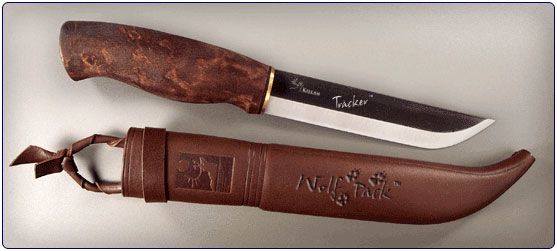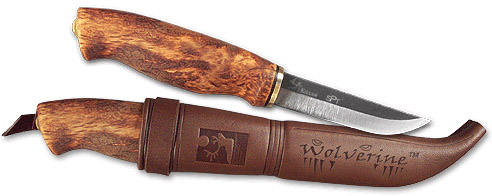i've been using a kellam wolverine as my main knife for about 5 years now, i think it's a cracking knife. as mojoracing said it all depends on what you want to do with it, but here's a few of my thoughts on some basic bushcraft uses.
fire lighting:
feather sticks - it's a scandi grind, pretty much perfect for making feathersticks
firestick (ferro rod) - when i got my wolverine it had a fairly rounded edges to the spine of the blade and wouldn't throw a spark at all, i spent a couple of minutes with a file putting an angled edge on one side of the spine and now it works pretty well. it doesn't throw sparks as well as a "proper" striker or a hacksaw blade but it does throw plenty good enough sparks to light your tinder.
flint - this is a pretty new technique to me so i'm the limiting factor with this but i can get pretty decent sparks from the spine, it works.
batoning - the decent blade thickness and scandi grind make the wolverine pretty good at splitting kindling, the only limitation is the fact that the blade is pretty short so anything over about 2" thick and you're having to baton pretty close to the tip of the blade. that said i've split firewood up to 3" without any problems, there's just not much blade left to baton.
food prep:
skinning - all i've skinned with this knife is a few rabbits, not a great test but one that it passed with flying colours.
veg prep - to be honest i think that the blade is a little bit thick for veg prep but then the same could be said about nearly all "bushcraft" knifes, i use an opinel for veg prep.
woodcarving:
roughing out - the handle shape of the wolverine makes it very useable with a variety of grips, it's more comfortable than you'd think to use both upside down and back to front. it is possible to chip the edge of the blade when making powerful cuts, especially chopping/slashing type cuts.
fine work - the scandi grind is perfect for removing small amounts of wood, it works well as a draw knife for smoothing and final shaping. the thickness of the spine is nice and comfortable to press your thumb against and the total lack of ricasso means that you can work right up to the handle where you have most power and control.
detail work - the one way that i think the wolverine is limited as a woodcarving knife is the depth of the blade (it's quite shallow) which makes it less than ideal to use for really fine detail work such as chip carving or kohlrosing, a deeper balde such as those found on a woodlore or bushtool would be better for this kind of work.
overall i think that the wolverine is a great all round knife, it has its limitations but as a compromise it's bound to. i'd happily recommend it to anyone as a main bushcraft knife and if i was to carry onlt one tool then i'd choose this one.
hope that helped a little
cheers
stuart




